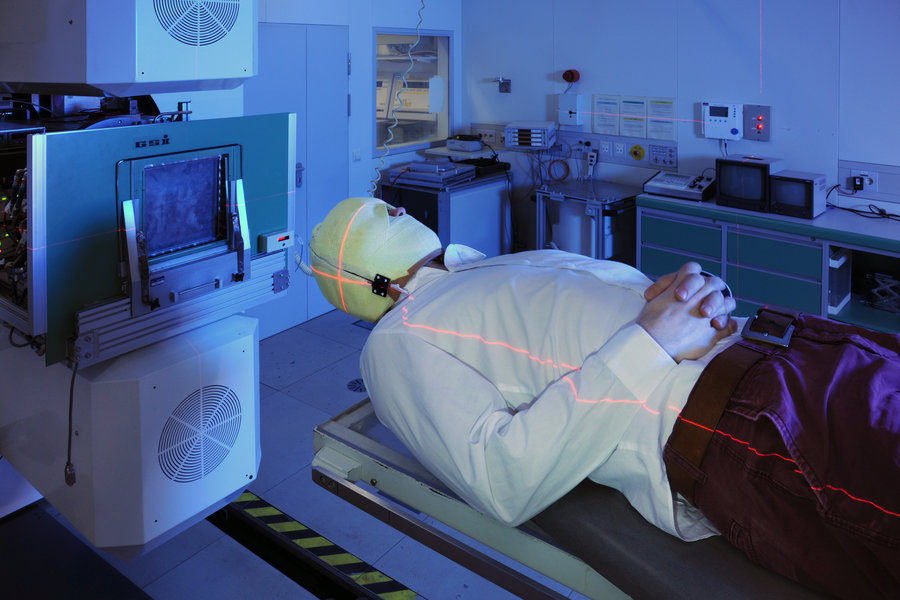25 years of tumor therapy: Precise weapons in the fight against cancer
10.08.2023 |
It was the starting point of a success story and is an outstanding example of successful technology transfer: 25 years ago, clinical studies of an innovative cancer treatment using accelerated carbon ions started at GSI Helmholtzzentrum für Schwerionenforschung. In August and September 1998, the first patients were treated with a complete course of carbon therapy for a period of three weeks. In the following years, the path led from fundamental research to a widespread medical application. As a pioneer of heavy ion therapy in Europe, GSI has become a central research center in this field today.
The novel heavy ion therapy was pioneered in joint research of the GSI Helmholtzzentrum, the Clinic of Radiology and the German Cancer Research Center (DKFZ) in Heidelberg, and the Rossendorf Research Center FZR (today’s Helmholtzzentrum Dresden-Rossendorf, HZDR). Individual radiation treatment with heavy ions had initially been conducted as early as December 1997. This had been preceded by four years of technical development of the therapy unit at the heavy-ion accelerator of GSI, which included a radiation facility for patients, and by 20 years of fundamental research in radiation biology and physics. Initiator and the crucial pioneer of this tumor therapy was Professor Gerhard Kraft. He established GSI’s biophysical research department already in the early 1980s and was its head from 1981 to 2008.
Worldwide innovations were the extremely target-conform irradiation with the raster scanning method, the biological irradiation planning and the visualization of the beam in the patient with a special recording device, the PET camera (Positron emission tomography).
In the period until 2008, GSI used carbon ion beams to treat more than 440 patients for tumors of the head and neck with great success. Today, special clinics in Heidelberg (Heidelberg Ion-Beam Therapy Center — HIT), Marburg (Marburger Ionenstrahl-Therapiezentrum — MIT) and Shanghai (SPHIC) offer customized versions of the treatment that was first used at GSI in Darmstadt 25 years ago. GSI played a major role in the development of these three facilities. In the meantime, the three-dimensional scanning technology has become standard in all new particle therapy facilities. The three centers, HIT, MIT and SPHIC, have treated more than 10,000 patients to date.
Today, Professor Marco Durante is the head of GSI biophysics. He is a renowned expert in the field of particle therapy and current president of the Particle Therapy Co-Operative Group (PTCOG), a worldwide organization of scientists and professionals interested in proton, light ion and heavy charged particle radiotherapy. He was elected by the PTCOG Steering Committee, to which each clinical particle therapy center in the world sends representatives.
Professor Durante and his team are working with great international attention on constantly improving the method through new technologies and treatment procedures and to make it even more powerful. For example, FLASH irradiation - the application of an ultra-high radiation dose in a very short time - is currently the focus of much attention worldwide and is advanced with great expertise at GSI. Other research questions include the treatment of moving tumors on internal organs and possible combinations of heavy ion and immunotherapy.
The international accelerator center FAIR currently being built at GSI will expand the research possibilities for next-generation particle therapy even further, for example by using beams with high intensities or radioactive ions for online PET imaging. Tumor therapy with heavy ions thus still provides broad potential for further scientific findings, so that it can be used even more effectively for the benefit of many patients in the future.
How significant the development and research of tumor therapy with heavy ions is for medicine is confirmed 25 years after the start in Darmstadt by current clinical studies on carbon ion radiotherapy conducted at the HIT in Heidelberg. To date, research at the HIT has produced clinical evidence of the safety and efficacy of carbon ion beam therapy in several areas: depending on the type of tumor, they show good tolerability of the therapy, combined with an effective fight against the treated tumor.
The Scientific Managing Director of GSI and FAIR, Professor Paolo Giubellino, emphasizes the great benefit for society: "The ion beam therapy developed at GSI is an outstanding example of how society and people can benefit from basic research through successful technology transfer. Together with strong partners, we are working hard to further develop new technologies and methods to ensure that our scientific breakthroughs continue to benefit society in the future, in medicine and other areas such as materials research or computer technology." (BP)
Scientific Background: The tumor therapy with heavy ions
Treatment with ion beams is a very precise and highly effective, yet extremely gentle, therapeutic process. The major advantage of this method is that the ion beams, which have previously been brought to very high speeds in the accelerator facility of GSI, develop their strongest effect in the tumor itself, while sparing the healthy tissue that surrounds it. Because the range of the heavy-ion beam can be controlled with millimeter precision, particles are stopped inside the tumor and can release their energy there in a concentrated burst.
The raster-scan method, which was also developed at GSI and was used in heavy-ion therapy for the first time, enables the carbon beam to cover the tumor very precisely. The radiation dose can be applied to the malignant tumor tissue point by point in three dimensions. In order to control the effect, the beam is left at each point until the intended dose is reached. Despite the large number of up to 50000 individual beam spots, the irradiation of a field takes only a few minutes. This process makes it possible to irradiate very precisely tumors with complex shapes.
More information
Ion-beam radiotherapy in the fight against cancer
Association for the promotion of tumor therapy with heavy ions











